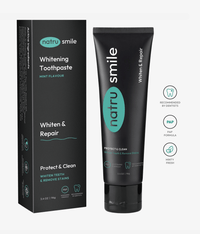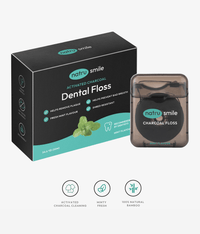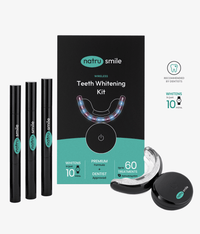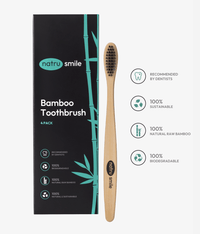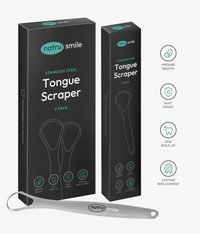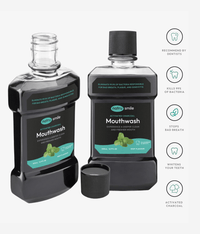
All products are certified by dental expert Dr. Greg Grillo
When it comes to oral health, infections can often be the silent enemy. People may not realize they have an infection until it is too late and more serious problems arise.
According to the WHO Global Oral Health Status Report from 2022, nearly 3.5 billion people worldwide are affected by oral diseases. Luckily, many of the most common oral infections can be treated and prevented with proper care. Knowing what the 8 most common oral infections are and how they can be treated is key to maintaining good oral health.
Ready to find out more about the most common oral infections and their treatment options? Read on.
Oral Infections: A Quick Look
Imagine this scenario: you have a toothache. You assume it’s just a cavity and nothing serious, but when you go to the dentist, they tell you that it’s actually an oral infection. Oral infections are caused by harmful bacteria or viruses that invade the mouth and cause damage to your gums, teeth, and other parts of your mouth.
While some people might have an inkling that they have an infection, others may not even realize it. Mouth infections can occur inside and outside the mouth and can range from mild to severe.
8 Types Of Common Mouth Infections
Whether you're dealing with an oral infection or simply want to brush up on your knowledge, we’ll go into the 8 most common types of oral infections.
Dental Caries Or Cavities
Dental caries, also known as cavities, are one of the most common oral infections people face. They're caused by a combination of factors, including bacteria in the mouth, a sugary diet, and poor oral hygiene.
After eating sugary or starchy foods, the bacteria in your mouth feed on carbohydrates and produce acid. Over time, this acid can break down the enamel on your teeth, which is the hard, protective outer layer. Once the enamel is compromised, the bacteria can enter the inner layers of the tooth, causing decay and eventually leading to a cavity.
Cavities can cause a range of symptoms, including tooth sensitivity, pain when chewing, and visible holes or pits in the affected tooth. If left to their own devices, they can eventually turn into more serious issues, such as infection, abscesses, and even tooth loss.
Fortunately, cavities can often be prevented by implementing good dental health practices, such as brushing, flossing daily, and visiting the dentist for regular teeth cleanings and checkups.
If you do develop a cavity, your dentist will perform a filling procedure for you and remove the decayed portion of the tooth to restore the tooth's structure and function.
Gingivitis
We’ll continue on with another internal oral infection - gingivitis. It's a type of gum disease that causes inflammation and irritation in the gums, and it's often caused by poor oral hygiene.
When you don't brush and floss regularly, plaque can accumulate on your teeth and gums. Plaque is a sticky substance made up of bacteria that can harden into tartar if it's not removed.
Plaque and tartar buildup can cause your gums to become inflamed, red, and swollen, which is a sign of gingivitis. Other symptoms of gingivitis include bleeding gums, bad breath, and receding gums.
The good news is that gingivitis is often reversible with proper oral hygiene. Take the time to brush your teeth twice a day, floss every day, and use an antiseptic mouthwash. Your dentist may also recommend a professional cleaning to remove any plaque and tartar.
Periodontal Disease
If left untreated, gingivitis can progress to a more severe type of gum disease called periodontitis, which can cause tooth loss and other complications.
Periodontal disease affects the tissues and bones that support your teeth. It's caused by a buildup of bacteria in the mouth, which can lead to inflammation, swollen and bleeding gums, infection, bad breath, receding gums, and loose teeth.
Several factors can increase your risk of developing periodontal disease, including poor oral hygiene, smoking, genetics, and certain medical conditions. If you think you may have periodontal disease, call your dentist as soon as possible to book an appointment for evaluation and treatment.
Treatment for periodontal disease can vary depending on the severity of the infection. In some cases, scaling (a deep cleaning procedure) and root planing may be recommended to remove plaque and tartar buildup. In more advanced cases, surgical procedures may be necessary to repair damaged tissues and bones.
Thrush
Moving away from the teeth, thrush is caused by an overgrowth of yeast in the mouth. You’ll most commonly see it in infants and older adults, as well as people with weakened immune systems or certain medical conditions.
Thrush can cause a range of symptoms, including white patches on the tongue, cheeks, and roof of the mouth, as well as redness and soreness in the affected areas. It can also cause a burning sensation or difficulty swallowing.
The infection is often caused by an imbalance of bacteria in the mouth, which can be due to a variety of factors, including medications, certain medical conditions, and poor oral hygiene. It’s also possible for it to spread from person to person, particularly between mothers and infants during breastfeeding.
Treatment for thrush typically involves antifungal medications, which can be prescribed by a healthcare professional. In addition to medication, practicing good oral hygiene, such as brushing your teeth and tongue regularly, can help prevent thrush and other oral infections.
Canker Sores
The least serious of the list, canker sores are a type of oral infection that can cause painful sores inside the mouth. They’re also called aphthous ulcers. You can identify them as small, round, or oval-shaped ulcers with a white or yellow center and a red border.
These sores can develop due to a variety of factors, including stress, hormonal changes, certain foods, and injury to the mouth. They aren’t transmissible and usually go away on their own within a week or two.
Canker sores can be uncomfortable, but they are usually not serious and do not require treatment. However, over-the-counter topical medications, such as gels or creams, can help relieve pain and promote healing.
To prevent canker sores, it’s recommended to practice good oral hygiene, avoid foods that may trigger them, and manage stress levels. If you experience recurrent or severe canker sores, you may want to book a dentist appointment to rule out any underlying medical conditions.
Oral Herpes
Oral herpes is synonymous with cold sores or fever blisters and is a common viral infection that affects the mouth and lips. It's caused by the herpes simplex virus (HSV) and can be transmitted through close contact with an infected person.
Oral herpes presents as small, fluid-filled blisters on or around the lips, which can be painful and uncomfortable. The blisters may burst and form a crust, which can take several days to heal. Some people may also experience symptoms such as fever, swollen lymph nodes, and muscle aches.
While there is no cure for it, antiviral medications can work to reduce the severity and duration of outbreaks. Over-the-counter creams and ointments can also help relieve symptoms such as pain and itching.
To prevent the spread of oral herpes, you should avoid close contact with those who have active outbreaks and practice good hygiene, like washing your hands often and avoiding touching your mouth or face. Don’t forget to avoid sharing personal items such as towels, razors, and utensils with others.
Herpangina
Herpangina is a viral infection that primarily affects children and is caused by the Coxsackie virus. In contrast to canker sores, which are found in the mouth and are not painful, herpangina causes small, painful sores or ulcers that develop on the tonsils and in the back of the throat.
Symptoms of herpangina can include fever, sore throat, difficulty swallowing, and a general feeling of being unwell. The ulcers may be red or yellow and can be painful, making it uncomfortable to eat or drink.
Although it may sound serious, it can be characterized as a mild infection that resolves on its own within a week or two. Pain relievers can help alleviate symptoms such as fever and throat pain, while gargling with salt water may help soothe the ulcers.
You’ll want to prevent the spread the same way you would with oral herpes. As well, children who are infected should avoid going to school or daycare until their symptoms have resolved.
In rare cases, herpangina can lead to complications such as dehydration or meningitis. So, keep an eye out and seek medical attention if you or your child experience severe symptoms or if symptoms do not improve after a few days.
Hand, Foot And Mouth Disease
Another oral infection more commonly seen in children is hand, foot, and mouth disease (HFMD). HFMD is a viral infection that is seen mostly in children under the age of 5, although it can also affect older children and adults. It's caused by the Coxsackie virus, just like herpangina, and is characterized by a rash or blisters on the hands, feet, and inside the mouth.
If infected, it can result in fever, sore throat, and a rash or blisters that appear on the soles, palms, and inside the mouth. Most of the time, it’s a mild infection that will go away on its own within a week or two. For those seeking some relief, they can opt for over-the-counter medication and drink plenty of fluids to help prevent dehydration.
Early Signs Of Oral Infection
Catching oral infections early is key to preventing more serious health problems. To help you identify and address infections quickly, these are some signs to look out for.
Recurring Bad Breath
Bad breath that doesn't go away even with regular brushing and flossing can be a sign of an oral infection. Bacteria that populate the mouth can cause a foul odor, and chronic bad breath may indicate an infection that needs to be treated.
Bleeding Or Sore Gums
Gums that bleed or are sore to the touch may be a sign of gum disease or infection. If this is the case, your dentist may recommend a deep cleaning of your teeth to remove any plaque or tartar.
Tooth, Gum, Or Jaw Pain
Any kind of pain in the mouth, gums, or jaw should not be ignored. It could hint towards an infection or abscess. Depending on the cause of your pain, they may prescribe antibiotics to fight off infection-causing bacteria or recommend a root canal to remove any infection in teeth roots.
Tooth Sensitivity To Hot Or Cold Foods
If you’re experiencing tooth sensitivity to hot or cold foods or drinks, this may be a sign that your teeth are infected. Sensitivity is the result of a thinning or wearing away of the enamel on your teeth, which can be caused by bacteria. To treat tooth sensitivity, your dentist may recommend fluoride treatments or prescribe medication.
Swelling Of The Gums, Jaw, Or Lymph Nodes
As opposed to a tooth, gum, or jaw pain, swelling is a sure sign of inflammation. If antibiotics don’t do the trick, surgery might be recommended to treat the issue.
Loose Teeth
Loose teeth can be a sign of an infection or another dental problem. An infection may cause the gums to weaken or pull away from the teeth, which can lead to them becoming loose.
Sores In The Mouth, Gums, Or Lips
Sores that develop in the mouth, gums, or lips may be a sign of an infection or other oral health issues. If you aren’t aware of the cause, have any sores examined by a dentist or healthcare professional to determine the underlying cause and receive appropriate treatment.
Home Remedies For Common Oral Infections
While you’ll want to see a medical professional for diagnosis and treatment of your infection, there are some home remedies that can help you manage your symptoms.
Essential Oils
Essential oils such as peppermint, orange, and eucalyptus oil have natural antimicrobial properties that can help fight oral infections. You can dilute a few drops of essential oil in coconut oil or another carrier oil and apply it to the affected area, or add a few drops to your mouthwash or toothpaste.
Saltwater Rinse
A saltwater rinse is a simple and effective home remedy for oral infections. Swish a solution of warm water and a teaspoon of salt around your mouth for 30 seconds before spitting it out. This can help kill bacteria and reduce inflammation in the mouth.
Herbal Tea
Herbal teas such as chamomile, sage, and echinacea can help soothe sore gums and relieve pain associated with oral infections. Steep a tea bag in hot water and let it cool before placing it on the affected area for a few minutes.
Cold Compress
A cold compress can help lessen swelling and relieve pain associated with oral infections. Wrap a small handful of ice cubes in a towel and apply it to the affected area for 10-15 minutes at a time.
When To See A Doctor
If you suspect you have an oral infection, it's important to see a doctor or dentist as soon as possible. Delaying treatment can lead to more serious problems, such as tooth loss or the infection spreading to other parts of the body. Home treatments and remedies *can* work, but they can only go so far.
Here are a few good signs that you should see a doctor:
- Severe, persistent toothache or pain in your gums
- Swollen, red or bleeding gums
- Pus or discharge coming from your gums or teeth
- Bad breath that doesn't go away with proper oral hygiene
- Difficulty swallowing or opening your mouth wide
- Fever or chills
Your oral health is important; don't hesitate to seek professional help if you're experiencing any of these symptoms.
If you’re interested in learning more about oral infection, we address some popular questions in the following FAQ section.
Is Oral Infection Serious?
Oral infections can be serious. Especially if they’re not treated, they can lead to more serious issues such as tooth decay or gum disease. Taking preventative measures, visiting your dentist regularly for checkups, and taking good care of your teeth at home are all key steps in keeping your mouth healthy.
What Are The Common Bacteria Found In The Mouth?
The bacteria found in the mouth and on the tongue are known as oral flora. These bacteria are essential to good oral health but can sometimes cause infection if they become unbalanced or overgrown. Common strains of oral flora include streptococcus, staphylococcus, lactobacillus, actinomyces, and porphyromonas.
Which Medicine Is Best For Mouth Infections?
Antibiotics are the most common treatment for oral infections. Depending on the infection, your doctor may prescribe an antibiotic such as penicillin or amoxicillin.
For more serious infections, a stronger antibiotic like clindamycin may be necessary.
Can Oral Infection Spread To The Body?
Surprisingly, infections in the mouth can end up affecting other parts of the body if left untreated. For example, an infection in your mouth can travel to other organs, such as your heart or lungs. That’s why it’s important to get any oral infection treated promptly and properly.
When Should I Be Concerned About An Oral Infection?
You should be concerned about an oral infection if you’re noticing any of the following symptoms: pain, redness, swelling, bad breath, or a change in taste.
Can You Get An Oral Infection From Kissing?
Many oral infections, including HFMD, oral herpes, and thrush, can be spread through close contact, such as kissing. Bacteria and viruses can be passed from one person's mouth to another during kissing, especially if one or both people have an active infection.


